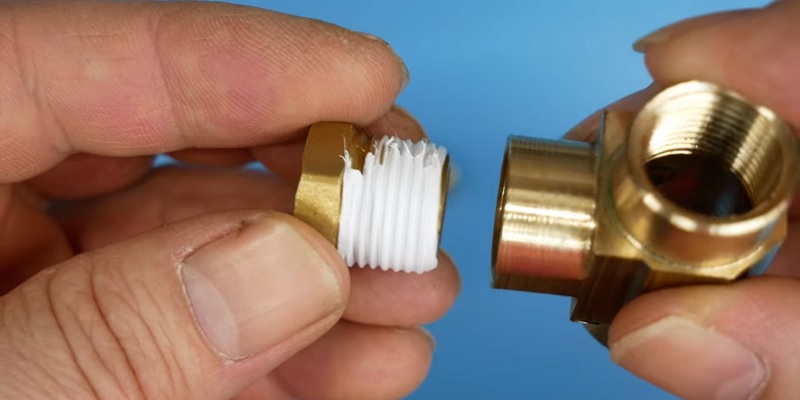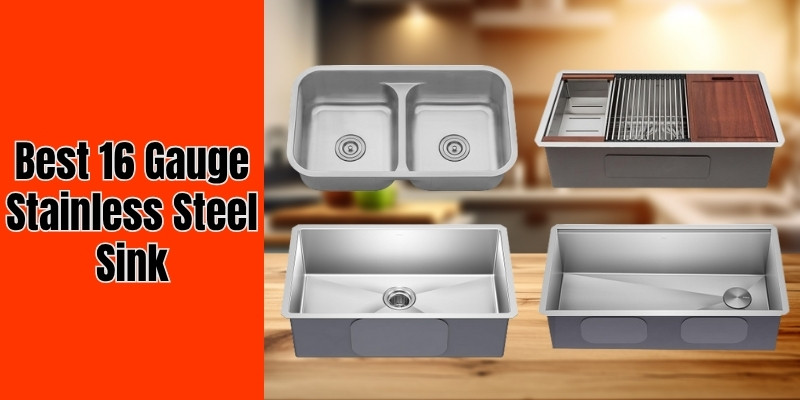Disclosure: This post contains affiliate links and I will be compensated if you make a purchase after clicking through my links. Learn More
Proper plumbing techniques are essential for ensuring the longevity and functionality of your plumbing system. One common question that arises among DIY enthusiasts and professionals alike is whether to use Teflon tape on brass fittings.
In this comprehensive guide, we will explore the properties of Teflon tape and brass fittings, discuss the situations where using Teflon tape is appropriate, and provide step-by-step instructions on how to properly apply it for optimal results.

What is Teflon Tape?
Teflon tape, also known as plumber’s tape or thread seal tape, is a thin, stretchy tape made from polytetrafluoroethylene (PTFE). This material is known for its excellent sealing properties and resistance to chemicals, heat, and friction. Teflon tape is commonly used in plumbing to create watertight seals on threaded connections, preventing leaks and ensuring a secure fit.
The tape is designed to fill in the gaps between the threads of pipes and fittings, creating a more even surface for a tighter seal. It also acts as a lubricant, making it easier to tighten the fittings without causing damage to the threads. Teflon tape is compatible with a wide range of plumbing materials, including metal and plastic, making it a versatile tool in any plumber’s arsenal.
Brass Fittings in Plumbing
Brass is a popular choice for plumbing fittings due to its durability, resistance to corrosion, and ability to withstand high temperatures and pressures. Brass fittings are commonly used in various plumbing applications, such as connecting pipes, valves, and fixtures. They are available in a range of sizes and configurations to suit different needs, from compression fittings to threaded fittings.
One of the main advantages of using brass fittings is their longevity. With proper installation and maintenance, brass fittings can last for decades without deteriorating or leaking. They are also relatively easy to work with, as they can be soldered, threaded, or compression-fitted, depending on the application.
Should You Use Teflon Tape on Brass Fittings?
The short answer is yes, in most cases, using Teflon tape on brass fittings is recommended. Here are some reasons why:
1. Enhancing the seal: Teflon tape helps create a tighter seal between the threads of the brass fitting and the connecting pipe or fixture. This is especially important in situations where the threads may not be perfectly aligned or have slight imperfections, which could lead to leaks if left unsealed.
2. Preventing leaks: By filling in the gaps between the threads, Teflon tape prevents water or other fluids from seeping through the connection, ensuring a leak-free joint. This is crucial for maintaining the integrity of your plumbing system and avoiding costly water damage.
3. Protecting threads from damage: Applying Teflon tape to the threads of brass fittings helps protect them from damage during installation. The tape acts as a lubricant, reducing friction and allowing the fittings to be tightened more easily without the risk of stripping or cross-threading.
However, there are some situations where using Teflon tape on brass fittings may not be necessary:
Factory-sealed fittings: Some brass fittings come with a pre-applied sealant or gasket, which eliminates the need for additional Teflon tape. In these cases, applying tape may actually interfere with the proper sealing of the fitting.
Compression fittings: Compression fittings, which use a ferrule and nut to create a seal, do not require Teflon tape. The compression mechanism itself is designed to create a watertight seal without the need for additional sealants.
It’s important to note that while Teflon tape is generally beneficial, there are some potential drawbacks to using it on brass fittings:
1. Over-tightening and stripping threads: If too much Teflon tape is applied or the fitting is over-tightened, it can lead to stripping the threads or damaging the fitting. This is why it’s crucial to use the right amount of tape and tighten the fitting according to the manufacturer’s specifications.
2. Improper application leading to leaks: If the Teflon tape is applied incorrectly, such as in the wrong direction or with too few wraps, it may not provide an adequate seal, resulting in leaks. Following proper application techniques is essential for ensuring a reliable, leak-free connection.
How to Properly Apply Teflon Tape on Brass Fittings
Now that we’ve established the benefits of using Teflon tape on brass fittings, let’s go through the steps for properly applying it:
1. Preparing the fitting and tape
- Clean the threads of the brass fitting with a wire brush or cloth to remove any dirt, debris, or old sealant.
- Cut a piece of Teflon tape approximately 6-12 inches long, depending on the size of the fitting.
2. Wrapping technique and direction
- Start by aligning the end of the tape with the start of the threads, leaving about a 1/2 inch overhang.
- Wrap the tape around the threads in the direction of the threads (usually clockwise when looking at the end of the fitting). This ensures that the tape will tighten when the fitting is screwed in, rather than unraveling.
- Overlap each wrap by about 50% to ensure full coverage of the threads.
3. Ensuring the right amount of tape is used
- For most applications, 2-3 wraps of Teflon tape are sufficient. Using too much tape can lead to over-tightening and damaging the threads.
- After wrapping, press the tape firmly onto the threads to ensure good adhesion.
- Trim off any excess tape at the end of the threads, leaving about a 1/4 inch overhang.
4. Tightening the fitting correctly
- When screwing the fitting into place, make sure to follow the manufacturer’s torque specifications to avoid over-tightening.
- Tighten the fitting by hand until it is snug, then use a wrench to turn it an additional 1/4 to 1/2 turn.
- Be careful not to over-tighten, as this can strip the threads or damage the fitting, leading to leaks.
Alternatives to Teflon Tape for Brass Fittings
While Teflon tape is the most common sealant used on brass fittings, there are alternatives available, such as pipe dope (also known as thread sealant compound). Pipe dope is a paste-like substance that is applied directly to the threads of the fitting, serving a similar purpose to Teflon tape.
Advantages of using pipe dope include:
- Easier to apply in tight spaces or awkward angles
- Can fill larger gaps between threads
- Provides lubrication for easier tightening
Disadvantages of pipe dope compared to Teflon tape:
- Can be messier to apply and clean up
- May require more time to cure before putting the system under pressure
- Some formulations may not be suitable for certain applications (e.g., drinking water systems)
Ultimately, the choice between Teflon tape and pipe dope comes down to personal preference and the specific requirements of the project. In some cases, a combination of both sealants may be used for added protection.
Common Mistakes to Avoid
To ensure a successful and leak-free installation, be sure to avoid these common mistakes when using Teflon tape on brass fittings:
- Using too much or too little Teflon tape: Applying too much tape can lead to over-tightening and damaging the threads, while too little tape may not provide an adequate seal. Stick to the recommended 2-3 wraps for most applications.
- Applying tape in the wrong direction: Always wrap the tape in the direction of the threads (usually clockwise) to ensure that it tightens when the fitting is screwed in. Wrapping in the wrong direction can cause the tape to unravel and compromise the seal.
- Over-tightening the fitting: Follow the manufacturer’s torque specifications and avoid over-tightening the fitting, as this can strip the threads or damage the components. A snug fit with an additional 1/4 to 1/2 turn is usually sufficient.
- Not cleaning the threads before application: Dirt, debris, or old sealant on the threads can interfere with the proper sealing of the Teflon tape. Always clean the threads thoroughly before applying the tape to ensure the best possible seal.
Final Thoughts
In summary, using Teflon tape on brass fittings is generally recommended for creating watertight seals, preventing leaks, and protecting the threads from damage. By following the proper application techniques and avoiding common mistakes, you can ensure a reliable and long-lasting plumbing connection.
It’s important to remember that while Teflon tape is suitable for most brass fitting applications, there may be situations where alternative sealants or methods are more appropriate. When in doubt, consult a professional plumber to ensure the best approach for your specific project.
FAQs
Can I reuse brass fittings with Teflon tape?
While it is possible to reuse brass fittings that have had Teflon tape applied, it is recommended to remove the old tape and apply new tape before reinstalling the fitting. This ensures a clean, debris-free surface for the best possible seal.
What if I accidentally applied Teflon tape in the wrong direction?
If you’ve applied the tape in the wrong direction, it’s best to remove it completely and start over. Applying tape in the wrong direction can cause it to unravel when tightening the fitting, compromising the seal.
Can Teflon tape be used on other types of fittings besides brass?
Yes, Teflon tape is suitable for use on a variety of plumbing materials, including plastic, stainless steel, and other metals. However, always check the manufacturer’s recommendations for the specific fittings you are working with to ensure compatibility.
By understanding the properties of Teflon tape and brass fittings, and following proper application techniques, you can confidently tackle your plumbing projects and ensure reliable, leak-free connections.


